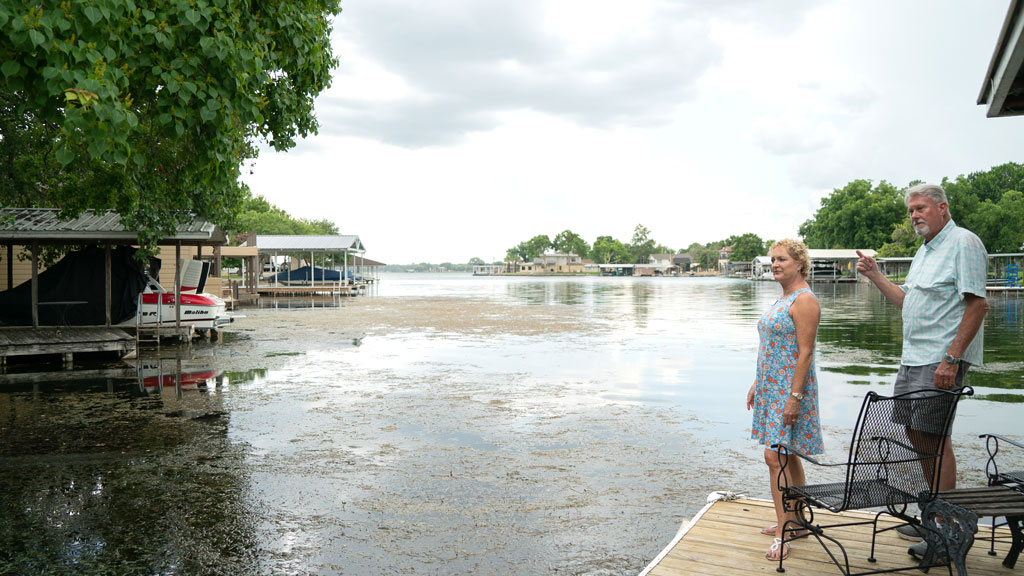Invasive hydrilla explodes across the Highland Lakes

A thick mat of hydrilla stretches out into Lake LBJ near the RR 1431 bridge in Kingsland, one of the most popular spots for boating and recreation. Staff photos by Dakota Morrissiey
The Highland Lakes are under attack. A widescale invasion of slimy, green proportions has made its way to the shores of Lake LBJ, and residents are looking for weapons to combat the menace.
Hydrilla and Eurasian watermilfoil are underwater weeds that clog personal watercraft intakes, become entangled in boat propellers, and make fishing from the shoreline and docks difficult, although they do provide good habitat for fish.
“It was about four months ago that we really started noticing it,” Sunrise Beach Village resident Rob Hardy told The Picayune Magazine in early June. “It came up in the space of a few weeks, and it got to the point where taking our boat out was a struggle.”

Hardy and wife Carol live on an open stretch of Lake LBJ. He is an elected member of the small town’s city council and she is a Realtor. Living on the water has given them a front-row seat to the rampant growth of invasive plant life that kicked off this spring.
Lake LBJ has been hit especially hard by the green wave because of its shallow coves, nutrient-rich sediment, and busy activity like construction along the shoreline that stirs up the water and soil, according to two experts at the Texas Parks and Wildlife Department.
“Hydrilla and Eurasian watermilfoil have been the most problematic species in recent years,” said Patrick Ireland, TPWD district supervisor of Inland Fisheries. “Aquatic invasive plants are typically introduced by boaters who fail to remove plants from their boats before going to a new lake, but they can also spread downstream by fragments.”
The two weeds have a lot in common with the hydrilla’s namesake, the Hydra, a Greek mythological water snake with multiple heads that regrow in pairs when one is chopped off. Like the monster, if one piece of hydrilla or milfoil is cut away, that piece can grow into a whole new plant. Making matters worse, both of these plants are extremely tough and fast-growing and can survive in a variety of conditions.

“One of the biggest challenges we’re currently facing with invasive plants on the Highland Lakes is with mechanical harvesting and escape of fragments that cause problems for other lakefront landowners,” said Monica McGarrity, TPWD senior scientist for Invasive Aquatic Species Management.
Hydrilla is found in at least 35 states; Eurasian watermilfoil in at least 48. Hydrilla came to the United States from the Korean peninsula in the 1950s, originally brought here for the aquarium trade. Eurasian watermilfoil, which is native across Europe, Asia, and North Africa, was established in the U.S. in the 1940s and might have been first brought here by ship to the Chesapeake Bay in the 1880s.
Along the Colorado River chain, Inks Lake is also suffering from the invasion. Travis and Buchanan aren’t as susceptible because lake levels fluctuate. The Lower Colorado River Authority lowered Lake Marble Falls last winter for dam repair, which kept the species from proliferating there, at least so far.
The two TPWD officials pointed to a few key factors that promote hydrilla and milfoil growth in general:
- Increased water clarity. Invasive zebra mussels filter the water, making it clearer. That allows more sunlight to penetrate the water, which fuels the rapid growth of plants such as hydrilla and milfoil. The lack of flow in the Colorado and Llano rivers also increases clarity.
- Landscaping activity. Fertilizers can run into the lake and feed the weeds, while lawn clippings that end up in the lake provide nutrients to plants near the shoreline.
- Drought. The lack of water flow gives the plants time to grow and establish themselves. The floods of 2018 helped clear the lake of invasive plant infestations, but the lack of rain in recent years has allowed for substantial growth to occur undisturbed.
The LCRA’s recommendations for prevention include not dumping lawn clippings into the lake, establishing a buffer of vegetation along the shoreline to capture runoff, and minimizing the use of fertilizers.

In Sunrise Beach Village, the Hardys recently paid to have their hydrilla and milfoil removed by professionals. Clear Water Weed Removal from Katy used specialized equipment to rip up the weeds from their small stretch of the lake. They paid another service to apply a specialized herbicide to kill the plants at the root. Total cost was $1,700 to rid their 83 feet of shoreline from the two invasive plants.
One group of nearby neighbors spent $21,000 combined to have the two menaces removed from in front of their adjacent homes.
Residents working together simultaneously is the only way to make a significant difference in the proliferation, the Hardys said. The two entities that have the most control over the lakes, the TPWD and LCRA, are only able to address invasives if they are causing significant damage or affecting hydroelectric power plants.
“People need to band together,” Carol Hardy said. “If just one person is doing it, it’s not going to work.”
The Texas Parks and Wildlife Department should be contacted at Patrick.Ireland@tpwd.texas.gov before any herbicidal treatments or mechanical means are used to remove aquatic vegetation. Those wanting to eradicate invasive plants must fill out an online form and include a map of the area and photos of the plant and the problems it is causing. The form can be found online at tpwd.texas.gov.

